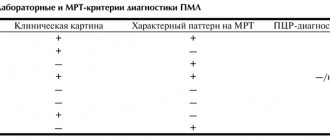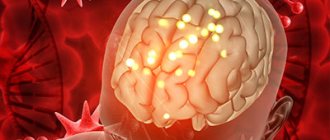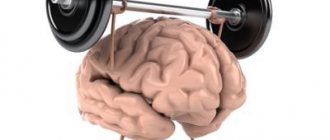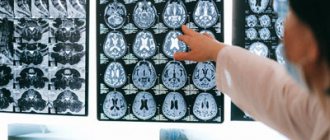Causes
There are not many reasons for the development of dyscirculatory encephalopathy. The main ones are hypertension and atherosclerosis. Discirculatory encephalopathy is less often spoken of when there is a tendency to lower blood pressure. Constant changes in blood pressure and the presence of a mechanical barrier to blood flow in the form of atherosclerotic plaques create the preconditions for chronic insufficiency of blood flow to various structures of the brain. Lack of blood flow means insufficient nutrition, untimely elimination of metabolic products of brain cells, which gradually leads to disruption of various functions.
It should be said that frequent changes in pressure lead to encephalopathy most quickly, while constantly high or constantly low pressure levels will lead to encephalopathy over a longer period of time.
A synonym for discirculatory encephalopathy is chronic cerebral circulatory failure, which, in turn, means the long-term formation of persistent disorders of the brain. Thus, the presence of the disease should be discussed only if vascular diseases are reliably present for many months and even years. Otherwise, you should look for another reason for the existing violations.
Clinical signs of the disease
The main symptoms of dyscirculatory encephalopathy appear already at stage 2 of the disease. The patient has neurological manifestations, mental changes, and emotional instability. At the last stage of the pathology, vascular changes are already irreversible, they are actively progressing, and the clinical picture is becoming brighter.
Characteristic signs of DEP grade 3:
- conflict, irritability, aggressiveness;
- deterioration of perception, problems with hearing and vision;
- problems with coordination, unsteady and shuffling gait, slow movements, small steps;
- apathy, lack of interest in affairs or others, indifference, inadequate reaction to what is happening;
- slurred speech, change in voice;
- decreased mental abilities, inability to solve the simplest intellectual problems;
- inability to control natural processes - urinary incontinence, problems with swallowing food;
- memory impairment, loss of ability to read and write;
- tremor of the limbs, paresis, paralysis, epileptic seizures.
If a patient is diagnosed with stage 3 DEP, this automatically means disability. Such a person is unable to lead a normal lifestyle, engage in work or ordinary daily activities. It is noteworthy that these patients themselves do not realize that they have problems and do not complain about changes in the body.
Symptoms
What should you pay attention to in order to suspect the presence of dyscirculatory encephalopathy? All symptoms of the disease are quite nonspecific and usually include “ordinary” symptoms that can also occur in a healthy person. That is why patients do not seek medical help immediately, only when the severity of symptoms begins to interfere with a normal life.
According to the classification of dyscirculatory encephalopathy, several syndromes that combine the main symptoms should be distinguished. When making a diagnosis, the doctor also determines the presence of all syndromes, indicating their severity.
- Cephalgic syndrome. Includes complaints such as headaches (mainly in the occipital and temporal regions), pressure on the eyes, nausea with headaches, and tinnitus. Any discomfort associated with the head should also be included in this syndrome.
- Vestibulo-coordinating disorders. They include dizziness, throwing up when walking, a feeling of instability when changing body position, blurred vision with sudden movements.
- Astheno-neurotic syndrome. Includes mood swings, persistently low mood, tearfulness, and feelings of distress. In case of pronounced changes, it should be differentiated from more serious psychiatric diseases.
- Dissomnia syndrome, including any sleep disorders (including light sleep, “insomnia”, etc.).
- Cognitive impairment. They combine memory impairment, decreased concentration, absent-mindedness, etc. If the impairment is severe and other symptoms are absent, dementia of various etiologies (including Alzheimer's disease) should be excluded.
What is hidden behind the diagnosis of dyscirculatory encephalopathy?
"Cerebral suffering due to impaired circulation." You probably haven't come across such a diagnosis. However, this is how it could be translated from Greek.
Encephalopathy. What kind of disease is this? Is this a disease at all? We talked about this and much more with Natalya Vladimirovna Umerenkova, a neurologist, leading specialist in the neurology department of the Expert Kursk Clinic.
— Natalya Vladimirovna, on the Internet you can find information that the diagnosis of discirculatory encephalopathy hides a lack of diagnosis. Is this really true or is dyscirculatory encephalopathy a disease?
This is actually a disease. Another question is that it can be called completely differently. For example, an equal sign can be placed between it and such pathologies as chronic cerebral ischemia, chronic cerebrovascular insufficiency. The problem is that none of these terms are reflected in the International Classification of Diseases (ICD-10). The term “dyscirculatory encephalopathy” is a legacy of medicine in the USSR and the post-Soviet era (as well as the countries of the post-Soviet space). It is rarely found in foreign medical literature.
Read the material on the topic: Vegetative-vascular dystonia: diagnosis or fiction?
As for diagnosis, sometimes the diagnosis of “dyscirculatory encephalopathy” is made redundantly - for example, simply focusing on the patient’s age (which is not always correct). Therefore, it is not always justified.
— Does dyscirculatory encephalopathy have degrees?
No, there are no degrees. There are stages of development of the disease (there are three of them), with manifestations characteristic of each of them.
— What are the symptoms of dyscirculatory encephalopathy?
In the first stage, minimal clinical manifestations are observed. These include general weakness, increased fatigue, a slight deterioration in concentration, some sleep disturbances, increased anxiety, higher emotional instability, headaches, and mild dizziness. An objective neurological examination and MRI of the brain also revealed minimal changes.
Read the material on the topic: What diseases can cause dizziness?
In the second stage, the symptoms become more clear and defined. These are headaches, imbalance, distinct dizziness, more pronounced cognitive and emotional-volitional disorders that are amenable to neuropsychological objectification. MRI reveals more distinct changes in the brain substance.
Read the material on the topic: If an MRI of the brain showed...
At this stage, some difficulties with daily activities appear. For example, some difficulties may be associated with obtaining new information, the need to read a lecture, find a new route to the store, etc., i.e. going beyond the boundaries of the “comfort zone”. Everyday forgetfulness is noted. At the same time, using habitual behavior patterns, skills and knowledge does not cause any problems.
The third stage of discirculatory encephalopathy is characterized by signs of parkinsonism, movement disorders, significant deterioration of cognitive functions and memory. The patient's critical attitude towards his condition suffers. Pelvic disorders are possible (urination suffers more often).
Read material on the topic: What is Parkinson's disease and how does it differ from parkinsonism?
With this disease, personality changes may be observed in the form of irritability, tearfulness, touchiness, and greater “viscosity” of thinking. Fine motor skills may deteriorate, there may be unsteady gait (even falls), episodes of forced laughter or crying, and some difficulty swallowing. There may be a change in the rate of speech, the appearance of dysarthria (fuzzy speech - as if there is “porridge in the mouth”).
— For what reasons does dyscirculatory encephalopathy occur?
They are varied. This is damage to large and small vessels, even small foci of previous strokes (including those that the patient may not know about and they may turn out to be an accidental finding during magnetic resonance imaging of the brain), etc.
Read the material on the topic: How to protect yourself from a stroke?
If we conceptually try to answer the question “why does discirculatory encephalopathy occur,” then one way or another it is associated with a disruption of the vascular bed and, accordingly, a deterioration in the blood supply to the brain. This can be caused by unstable blood pressure figures in hypertension, vascular atherosclerosis, vascular changes in diabetes mellitus, heart rhythm disturbances with a transient deterioration in blood supply to brain tissue or an increased risk of blood clots, independent disorders in the blood coagulation system (with increased thrombus formation) and some others .
— Who is at risk for dyscirculatory encephalopathy?
These are people with high blood pressure, atherosclerotic lesions of cerebral vessels, diabetes mellitus, pathologies of the blood coagulation system and vascular wall, smokers, and people suffering from physical inactivity.
Read the material on the topic: It's off scale! Looking for reasons for high blood pressure
— What other neurological diseases can masquerade as dyscirculatory encephalopathy?
They can be of very different nature. Similar manifestations can occur with brain tumors, hydrocephalus with normal cerebrospinal fluid pressure, tension headaches, and some types of migraine. This diagnosis can be mistakenly made if a person has dizziness that occurs against the background of phobic disorders or pathology of the inner ear. Similar manifestations occur in anxiety and depressive disorders, as well as a number of others.
Read the material on the topic: What is a tension headache?
— What methods does the diagnosis of dyscirculatory encephalopathy include?
Careful collection of complaints and medical history, as well as a detailed neurological examination.
Of the instrumental methods, as a rule, ultrasound of the vessels of the neck is performed (ultrasound duplex scanning of brachiocephalic vessels, not only arteries, but also veins), MRI of the brain (it is advisable to carry out with the vessels of the brain).
Read the material on the topic: Why is MRI of cerebral vessels prescribed?
The blood coagulation system is being studied.
According to indications, consultations with narrow specialists are prescribed - a cardiologist, an endocrinologist, an ophthalmologist.
— How are patients with dyscirculatory encephalopathy treated? Can its development be stopped?
If the diagnosis is correct, the correct treatment is prescribed and the patient fully adheres to it - yes, the disease can be stopped. The principles of treatment are to normalize blood pressure, blood sugar and lipids, and the rheological properties of blood (here “rheological” means “blood fluidity”). A proportionate level of physical activity and smoking cessation are required.
The drugs used are those that have a positive effect on the “nutrition” of brain tissue, improving blood circulation in it, etc. In severe stages, drugs against dementia and parkinsonism may be prescribed. A consultation with a psychiatrist may be necessary.
It should be remembered that drug therapy alone without eliminating the factors leading to the disease will not be very effective and, at best, will provide a temporary effect.
— What is the risk of dyscirculatory encephalopathy if it is not treated? Is it that dangerous?
Lack of treatment will lead to progression of the process. The prognosis directly depends on timely diagnosis and proper treatment.
You can make an appointment with a neurologist here
Please note: consultations are not available in all cities
— Natalya Vladimirovna, is it possible to prevent discirculatory encephalopathy? Tell us about the prevention of this condition
Fortunately, it is possible to prevent its development. No matter how simple it may sound, it is maintaining a healthy lifestyle: a balanced diet, an adequate level of physical and intellectual activity, and the absence of bad habits. If there are diseases and conditions that increase the risk of developing discirculatory encephalopathy, their timely and competent treatment is necessary.
Other
Discirculatory encephalopathy grades 1, 2 and 3 (description)
Also, in addition to the syndromic classification, there is a gradation according to the degree of encephalopathy. So, there are three degrees. Discirculatory encephalopathy of the 1st degree means the most initial, transient changes in brain function. Discirculatory encephalopathy of the 2nd degree indicates persistent disorders, which, however, only affect the quality of life, usually not leading to a severe decrease in ability to work and self-care. Discirculatory encephalopathy of the 3rd degree means persistent gross disorders, often leading to disability of a person.
According to statistical data, the diagnosis of grade 2 dyscirculatory encephalopathy is one of the most common neurological diagnoses.
Symptoms of DEP grade 3
At the third stage, all symptoms worsen and new ones are added. If at first the deviations in the functioning of the nervous system are insignificant, then gradually they reach their apogee. The patient ceases to be aware of his condition and does not criticize actions. Grade 3 is characterized by an aggressive behavior. A person’s intellect is impaired, persistent dementia develops, i.e. dementia. The patient is able to work for some time.
Symptoms expressed:
- severe dementia;
- urinary incontinence;
- movement disorder;
- speech disorders.
The main symptom is severe dementia
How does dementia manifest? This is a dysfunction of the intellect, in which the ability to comprehend the connection between events and phenomena surrounding a person is reduced. Cognition processes become worse, emotional reactions and character traits become poorer, some of them disappear. The patient ceases to distinguish between the important and the unimportant. A person does not notice such problems; they greatly affect relatives. In severe cases of dementia, a person loses speech skills and becomes incapacitated.
Usually the patient is given a disability. The most unfavorable course is observed against the background of diabetes mellitus. With grade 3 DEP, complications arise that further aggravate the situation.
Diagnostics
Only a neurologist can diagnose the disease. To make a diagnosis, an examination of the neurological status requires the presence of revived reflexes, the presence of oral automatism reflexes, pathological reflexes, changes when performing coordination tests, and signs of disturbance of the vestibular apparatus. You should also pay attention to the presence of nystagmus, deviation of the tongue away from the midline and some other specific signs that indicate the suffering of the cerebral cortex and a decrease in its inhibitory effect on the spinal cord and reflex sphere.
Only in addition to a neurological examination are additional research methods - REG, MRI and others. Rheoencephalography can reveal disturbances in vascular tone and asymmetry of blood flow. MRI signs of encephalopathy include the presence of calcifications (atherosclerotic plaques), hydrocephalus, and scattered vascular hypodense inclusions. Typically, MRI signs are detected in the presence of grade 2 or 3 dyscirculatory encephalopathy.
Discirculatory encephalopathy: the danger of pathology and treatment methods
This pathology is a brain lesion that occurs due to constant progressive circulatory disorders of the central nervous system of various etiologies. It affects motor, emotional and cognitive function, and depending on the severity of the symptomatic picture is divided into three stages. To make and confirm the diagnosis, ultrasound, echo-EG, EEG, REG, duplex scanning of cerebral vessels, ophthalmoscopy, MRI are required. Therapy is selected individually and consists of neuroprotective, antiplatelet, antihypertensive, vascular and other drugs.
Treatment
Treatment must be comprehensive. The main factor in successful therapy is the normalization of the causes that caused the development of the disease. It is necessary to normalize blood pressure and stabilize lipid metabolism. Standards for the treatment of dyscirculatory encephalopathy also include the use of drugs that normalize the metabolism of brain cells and vascular tone. Drugs in this group include Mexidol, Cytoflavin, Gliatilin, Sermion. The choice of other medications depends on the presence and severity of certain syndromes:
- In case of severe cephalgic syndrome and existing hydrocephalus, they resort to specific diuretics (diacarb, glycerin mixture), venotonics (detralex, phlebodia).
- Vestibular-coordinating disorders should be eliminated with drugs that normalize blood flow in the vestibular structures (cerebellum, inner ear). The most commonly used are betahistine (Betaserc, Vestibo, Tagista) and vinpocetine (Cavinton).
- Astheno-neurotic syndrome, as well as sleep disturbances, are eliminated by prescribing mild sedatives (glycine, tenoten, etc.). In case of severe manifestations, antidepressants are prescribed. You should also adhere to proper sleep hygiene, normalize the work-rest regime, and limit psycho-emotional stress.
- For cognitive impairment, nootropic drugs are used. The most commonly used drugs are piracetam, including in combination with a vascular component (fezam), as well as more modern drugs such as phenotropil, pantogam. In case of existing severe concomitant diseases, preference should be given to safe herbal-based drugs (for example, tanakan).
Treatment with folk remedies for dyscirculatory encephalopathy usually does not pay off, although it can lead to a subjective improvement in well-being. This is especially true for patients who are distrustful of taking medications. In advanced cases, such patients should be oriented to at least take constant antihypertensive therapy, and during treatment, use parenteral methods of treatment, which, in the opinion of such patients, have a better effect than tablet forms of drugs.
Stages of encephalopathy
Doctors call 3 stages of development of the disease, each of which has its own characteristics.
Stage 1
The patient experiences a feeling of slight discomfort: dizziness, headache, sleep problems, anxiety, noise in the head, minor memory problems, fatigue, decreased performance.
If the patient suffers from hypertension, blood pressure may increase. After rest, the symptoms disappear, so they do not pay attention to them. and problems with oculomotor ability appear Intelligence begins to decline.
Stage 2
The patient's symptoms intensify: memory problems appear more often, severe dizziness, poor coordination of movements - walking becomes unstable, narrowing of the arteries and dilation of the fundus veins.
The patient may have a mini-stroke. Often, when the second stage of the disease is detected, a disability is assigned.
Stage 3
The patient loses the ability to self-care. The patient's condition worsens and is accompanied by: fainting, epileptic seizures, memory loss, significant impairment of motor coordination, and significant intellectual impairment.
A person feels severe dizziness, sleep is disturbed, and noise in the head increases. Possible paralysis. The patient is not able to realistically assess his condition. Recovery of a patient at the third stage of pathology development is impossible.
In this situation, the question arises of the inability to perform work functions and everyone is assigned a disability.
Prevention
There are not many methods for preventing the disease, but standard treatment cannot do without prevention. To prevent the development of dyscirculatory encephalopathy, as well as to reduce its manifestations, you should constantly monitor the level of blood pressure, the content of cholesterol and its fractions. Psycho-emotional overload should also be avoided.
If you have dyscirculatory encephalopathy, you should also regularly (1-2 times a year) undergo a full course of vasoactive, neuroprotective, nootropic therapy in a day or round-the-clock hospital to prevent progression of the disease. Be healthy!
1.What is dyscirculatory encephalopathy and what are its causes?
Dyscirculatory encephalopathy, or DEP, is a disease that is very common in people with hypertension. DEP is a violation of blood circulation in the vessels of the brain.
What are the causes of dyscirculatory encephalopathy?
The main causes are hypertension and atherosclerosis, sometimes low blood pressure. Changes in blood pressure and atherosclerotic plaques lead to a lack of blood flow, and this causes insufficient cell nutrition and disruption of brain function.
A must read! Help with treatment and hospitalization!











